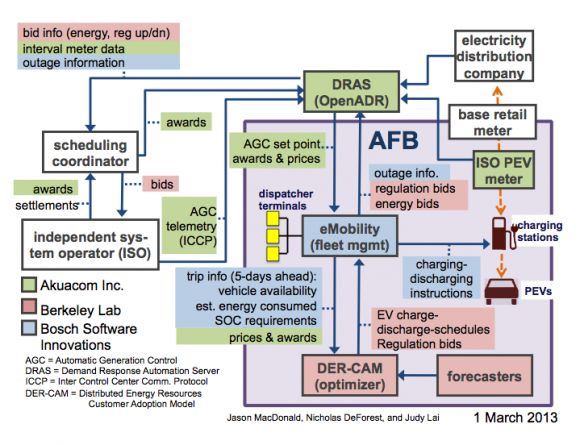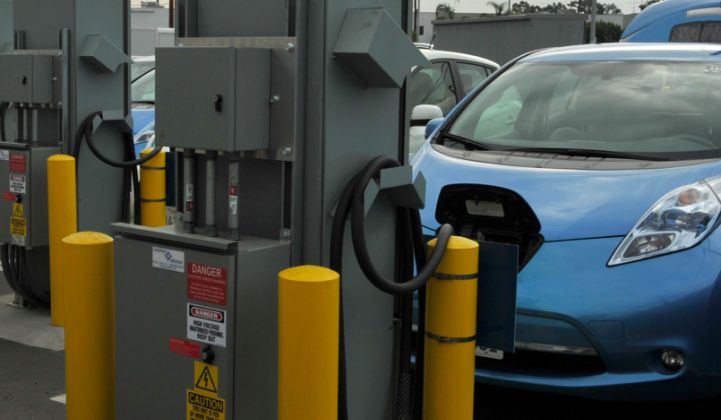Correction: Software for the L.A. Air Force Base V2G project was provided by Kisensum Inc. An earlier version of this story incorrectly stated Bosch Software Innovations’ eMobility Solution provided front-end EV management and charging tools.
The Los Angeles Air Force Base last week became the first federal facility to replace its entire fleet with plug-in electric vehicles, the majority of which also have bidirectional capability that enables them to participate in California’s energy markets.
The 42-vehicle fleet includes both pure electric and plug-in hybrid vehicles, including sedans, trucks and a twelve-passenger van. Thirty-six of the 42 electric vehicles (EVs) have the ability to exchange power with the grid and will be able to offer demand response and ancillary services, allowing the base to generate revenue that will partially offset fleet expenses.
The demonstration project is part of the Defense Department’s mission to decrease reliance on fossil fuels, meet energy-efficiency goals, reduce fleet costs and enhance the military’s operational capability. In the event of a power outage due to a disaster, the ability to pull power off the EV batteries can be used to provide energy resiliency.
Bidirectional power flow using EVs has been done before. What makes this project novel is its size and scale, as well as the variety of products the DOD is bringing to bear.
L.A. Air Force Base will have three different charging station types on site -- one from CHAdeMO and two models of SAE chargers. Kisensum Inc.'s On-Base Electric Vehicle Infrastructure software will provide necessary EV management and charging tools (the company replaced Bosch Software Innovations’ eMobility Solution last year). And Lawrence Berkeley National Laboratory’s Distributed Energy Resources Customer Adoption Model will be extended to deliver optimized fleet scheduling.
These systems will allow the EVs to participate in the California Independent System Operator (CAISO) Regulation Up and Regulation Down markets. Receipt of and fast response to grid instructions, as well as payment settlements from energy market participation, will all be enabled through the OpenADR protocol, so that companies and customers in other markets can also adopt the system.
Four other military installations will conduct the same tests on the benefits of bidirectional power flow at a smaller scale. All but one will be on-line by January. The installation sites were selected to represent a variety of operational settings and geographical climates, as well as different energy markets.
“By the end of this demonstration, there will be a pretty wide range of products available to the DOD, but also to others who want to replicate the project,” said Cameron Gorguinpour, special assistant to the assistant secretary of the Air Force for installations, environment and logistics.
Many of the technologies developed for the base project are completely new. Princeton Power Systems, for instance, developed thirteen CHAdeMO-based charging stations using its UL-certified bidirectional multi-port inverter, the GTIB-30.
“The idea of using an electric car to provide services to the grid is really nothing new, but…it’s only been done in a research setting,” said Darren Hammell, chief strategy officer at Princeton Power Systems. “We consider this the first real commercially scalable application. The stations and the vehicles are essentially available today, the costs are coming down, and we went through the normal permitting process to connect to the grid. We think it’s the first example of a really replicable setup -- and a sign of things to come.”
FIGURE: Data Flows in the Vehicle-to-Grid Model

Source: Lawrence Berkeley National Laboratory
The most difficult part of the project has been bringing together a wide range of stakeholders, said Gorguinpour. “The sheer number of entities involved is staggering,” he said.
To make the concept a reality, the DOD not only had to collaborate with the private sector to develop and build complex technologies, but the Public Utilities Commission also had to pass a resolution to enable vehicle-to-grid (V2G) projects in California, and CAISO had to create a V2G roadmap. The state government was also involved and contributed $5.3 million to support the endeavor. Several automakers and the General Services Administration (GSA) were involved in the process of vehicle acquisition.
The DOD, like all federal agencies, is required to make all new light-duty vehicle purchases alternative fuel vehicles by January 1, 2016. Last year, the DOD announced it had set aside $20 million for EV purchases. Including outside funding, the total dollar amount to execute the EV project including all underlying construction and engineering expenses on all five military bases came to $33 million.
The DOD is still navigating the costs of participation in the energy markets. Since it’s never been done before, it’s not clear yet how much an EV can generate by offering grid services in SCE territory. However, the DOD estimates that each EV could generate $150 per kilowatt per year if it was hooked up to the grid 24/7. Most of the acquired vehicles operate at 15 kilowatts, and so will earn some portion of $2,250 over the course of a year, or some portion of $187 each month.
For the Air Force Base demonstration, the aim is less about recouping expenses than it is about conducting research, said Gorguinpour. Rather, the DOD is trying to build a business case moving forward. If it is set up correctly, vehicle-to-grid capability could generate enough revenue to make acquiring EVs more cost-competitive than comparable gasoline vehicles.
In this particular case, the DOD purchased the majority of EVs it will be testing, but typically, the department leases its vehicles from automakers via the GSA. The Nissan Leaf, for instance, has a lease price of $199 per month. If that vehicle can earn $100 per month in revenue from ancillary services, which is within reason, the Leaf’s lease cost will be cut in half, not including fuel savings, reduced maintenance costs or other factors.
The only vehicles the DOD is leasing for the Air Force Base demonstration project are the pickup trucks. In this case, the DOD is leasing conventional gasoline-powered Ford pickup trucks through the GSA and paying for them to be adapted into hybrid plug-in vehicles. The pickup truck conversion is also fully reversible, so if the GSA doesn’t want the retrofit to continue, it can restore the truck to being solely gasoline-powered.
This deal represents a new business model for the DOD that could make it easier to gain access to alternative fuel technologies through the existing vehicle acquisition process. Going forward, the DOD is considering other novel arrangements with the GSA and third-party suppliers in order to take advantage of incentives that typically aren’t available to federal agencies.



